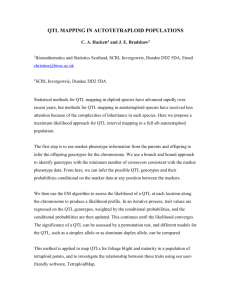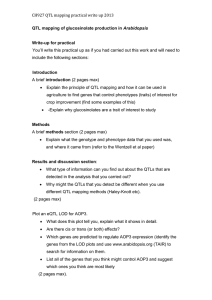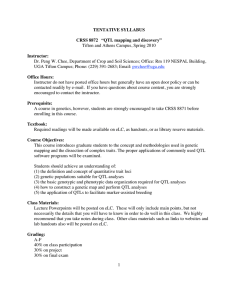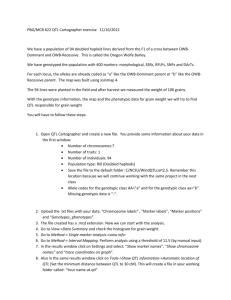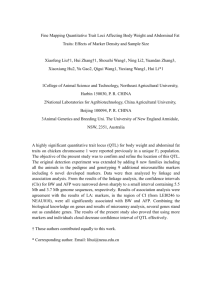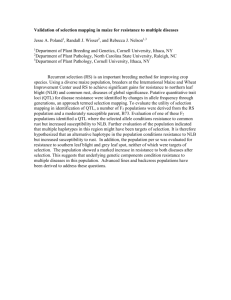Atlantic salmon disease QTL: Application of RAD Tag Sequencing Ross Houston
advertisement
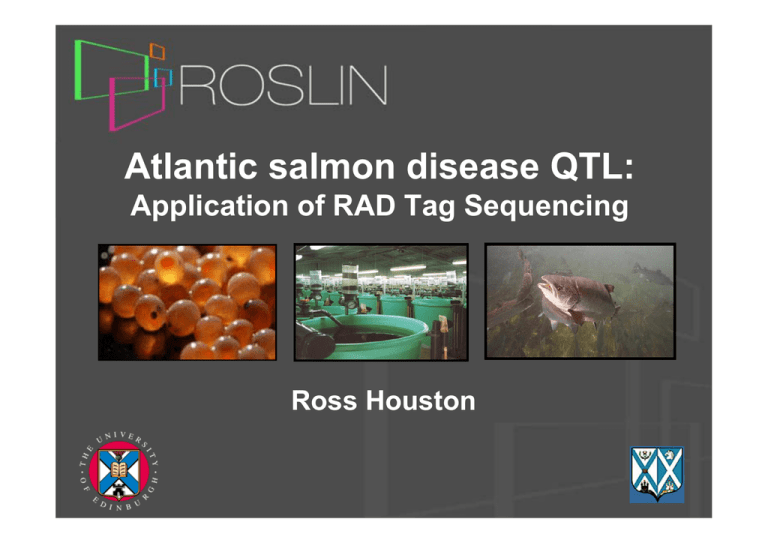
Atlantic salmon disease QTL: Application of RAD Tag Sequencing Ross Houston Outline • Introduction to Infectious Pancreatic Necrosis (IPN) in salmon • Results to date: – Major QTL affecting host resistance • freshwater lifecycle stage • seawater lifecycle stage • gene expression comparison alternative genotypes • Limitations in Atlantic salmon • Plan for applying RAD Tag sequencing Atlantic salmon • Important aquaculture species (European production value > $2billion) • Hatched in freshwater • Transferred to seawater ~ 1year IPN in Salmon • Infectious viral disease • Two specific windows of salmon lifecycle: • Fry IPN – salmon susceptible soon after hatching – mortalities up to 70% • Post-smolt IPN – salmon susceptible soon after seawater transfer – mortalities up to 40% IPN in Salmon • Genetics of resistance in seawater – moderate to high genetic component (30-50%) – single major locus on LG 21 overwhelmingly important 16 14 12 10 F Ratio F ratio 8 Genome-Wide Significance 6 4 QTL 2 0 0 10 20 30 40 50 60 70 Loctiongroup (cM) AS Linkage 21(cM) Freshwater IPN • Ongoing project 2007-2010 • Aims: – Investigate genetic control of fry IPN resistance – Compare gene expression profiles of alternative genotypes IPNV Challenge Experiments 1. Genetic architecture of fry IPN resistance • Heritability estimation and QTL mapping 2. Gene expression comparison • resistant and susceptible families 3. Gene expression comparison • alternative QTL genotypes within family Daily Mortalities Number of mortalities per day Number of days post-challenge Genetics Results • Polygenic heritability – – • QTL heritability (genotyped families only) – – • observed scale 0.26 (± 0.09) underlying scale 0.55 (± 0.05) h2 QTL 0.18 (± 0.03) h2 Poly negligible All genetic variation in ten genotyped families due to LG21 QTL! Mortality levels in fry with alternative QTL haplotypes (four families with both parents heterozygous) Dam Haplotype Sire Haplotype R R S 0 / 73 1 / 74 (0 %) S (1 %) 69 / 109 2 / 85 (2 %) (63 %) Experiment 2 Cumulative Mortality %age mortality 30 SUS Fam 1 SUS Fam 2 RES Fam 1 RES Fam 2 20 10 0 Sampling Timepoints 0 4 8 12 16 20 No. days post challenge 1 7 20 Transcriptomics Results: Resistant Families 1 day p.c. 7 day p.c. 20 day p.c. IPNV infected fish relative to same day controls Significant expression (P<0.05) with >twofold change highlighted Transcriptomics Results: Susceptible Families 1 day p.c. 7 day p.c. 20 day p.c. IPNV infected fish relative to same day controls Significant expression (P<0.05) with >twofold change highlighted Current Work • Gene Expression – – • Fine Mapping – – • Microarray comparison of alternative QTL genotypes within-family Pathway analysis of differentially regulated genes Additional markers, especially SNPs Candidate genes from gene expression studies Implementation – Improved marker-assisted selection in breeding program Limitations • Fine mapping QTL – – • Project to sequence salmon genome – • QTL in 3cM (~3MB) region limited by lack of available markers and incomplete BAC contig coverage first draft due end 2010 Lack of closely related model species RAD Tag Application • Aims: – Generate SNPs with focus on QTL region • • – linkage with QTL linkage disequilibrium with QTL Further investigation of SNPs of interest with large scale genotyping • need for SNP assay RAD Tag Application • QTL homozygous resistant and homozygous susceptible genotypes available across several families Dam Haplotype Sire Haplotype R R S 0 / 73 1 / 74 (0 %) S (1 %) 69 / 109 2 / 85 (2 %) (63 %) RAD Tag Application • Atlantic salmon genome – – estimated ~3 x 109 bp RE with 8bp site • • – average distance between sites ~65kb expect ~92K tags Partial genome duplication RAD Tag Application • Experimental design – LD markers • • • – pool ~6 unrelated RR individuals pool ~6 unrelated SS individuals look for SNPs matching QTL genotype across families Linkage markers • • several offspring of heterozygous parent look for SNPs linked to QTL within family RAD Tag Application • Questions/issues: – – – Obtaining sufficient sequence data to generate SNP assay for large scale genotyping? Positioning markers on the genome Duplicate regions Acknowledgments Steve Bishop Chris Haley John Taggart James Bron Brendan McAndrew William Starkey Almas Gheyas Derrick Guy Jose Mota-Velasco Alastair Hamilton Alan Tinch David Verner-Jeffreys Richard Paley Georgina Rimmer Ian Tew Karim Gharbi John Davey
